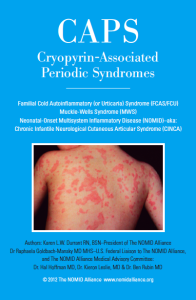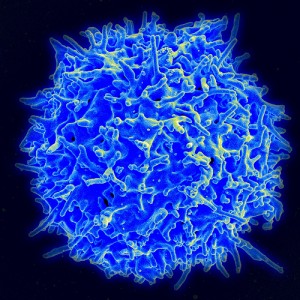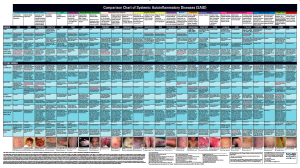
CAPS Guidebook produced by the Autoinflammatory Alliance. Click here to open.
Cryopryin-associated periodic syndromes include familial cold autoinflammatory syndrome (FCAS), Muckle-Wells syndrome (MWS), and neonatal onset multisystem inflammatory disease (NOMID). Below are some links to studies and other informative resources on these fever syndromes. This is not an all-inclusive list. For more research studies, search PubMed.gov.
Detailed information on FCAS, MWS, and NOMID can be found here at the Autoinflammatory Alliance website. Diagnosing, genetics, symptoms, and treatments are discussed at length.
Cryopyrin-Associated Periodic Syndromes (CAPS) Guidebook – You can download a PDF of this highly informative guidebook with photos of rashes here. This book was written by Karen Durrant, RN and Autoinflammatory Alliance founder and president and Dr. Raphaela Goldbach-Mansky MD MHS–U.S. Federal Liaison to The Autoinflammatory Alliance, Dr. Hal Hoffman, Dr. Kieron Leslie, and Dr. Ben Rubin.
American College of Rheumatology: Cryopyrin-Associated Autoinflammatory Syndromes (CAPS) – This is an easy to understand overview of CAPS. It’s especially good for sharing with family and friends to help explain yours or your child’s condition.
Cryopyrin-Associated Periodic Syndromes: Difficult to Recognize, Diagnose, Treat – Cases studies and details of the symptoms, pathogenesis, diagnosing, and treatment of the different CAPS diseases.
Some highlights from this study:
- “The most important issue is that existing damage is usually not reversible; thus, diagnosis and initiation of treatment need to be prior to development of damage. IL-1 inhibition improves existing hearing loss in only ~20–33% of patients and not after deafness has already occurred.14 Treatment usually prevents further hearing deterioration.”
- “In many patients, the dose and frequency of IL-1 inhibition therapy need adjustment over time, particularly in children and in those with a more severe phenotype. Anakinra can be increased up to 8–9 mg/kg/day and canakinumab to 600 mg (in children ≤40 kg, 8 mg/kg) every four weeks.31,33,35 Other patients may need less frequent administration of canakinumab.”
Canakinumab treat-to target strategies increase complete response rate in CAPS – Real-life effectiveness of canakinumab in CAPS was significantly lower than in controlled trials. Treat-to-target strategies may improve the outcome of children and adults living with CAPS.
NOMID Nomad – A Journey with Neonatal Onset Multisystem Inflammatory Disease – Follow the journey of Martha who was born with NOMID before it had a name or treatment.
Novel evidences of atypical manifestations in cryopyrin-associated periodic syndromes – “Our evidence suggests that CAPS may occasionally be presented as a late-onset, recurrent inflammatory disease without urticarial-like rash. In some patients, AA amyloidosis in strange locations like urinary bladder may complicate the clinical course.”
A New Syndrome in the Spectrum of Cryopyrin-Associated Periodic Syndromes (CAPS) Caused By the Novel R918Q NLRP3 Mutation – The rare R918Q mutation found on exon 7 causes a new CAPS syndrome that involves hearing loss and muscle weakness. Patients improved on anakinra.
Papillary edema in Muckle-Wells syndrome
Canakinumab in patients with cryopyrin-associated periodic syndrome: an update for clinicians – This is a comprehensive overview of CAPS symptoms, treatments, and long-term prognosis. It give detailed information on how Ilaris works in CAPS patients and dosing needed to control CAPs symptoms.
Successful management of cryopyrin-associated periodic syndrome with canakinumab in infancy.
Phenotypic and genotypic characteristics of cryopyrin-associated periodic syndrome: a series of 136 patients from the Eurofever Registry – This study evaluates the disease progression, including age of onset and severity based on the specific mutation.
Cryopyrin-associated periodic syndrome caused by a myeloid-restricted somatic NLRP3 mutation. – “These data document the possibility of myeloid-restricted somatic mosaicism in the pathogenesis of CAPS, underscoring the emerging role of massively-parallel sequencing in clinical diagnosis.”
Brief Report: Anakinra Use During Pregnancy in Patients With Cryopyrin-Associated Periodic Syndromes
Muckle-Wells syndrome in an Indian family associated with NLRP3 mutation – This is a case report of two Indian brothers diagnosed with MWS later in life. From the study, “In our family, the onset of the disease and symptomatology favor a diagnosis of MWS. The two patients also exhibited overlapping features with FCAS as shown by exacerbation of symptoms upon exposure to cold and NOMID like papilledema, chronic aseptic meningitis, and headache. The proband’s father had died of chronic kidney disease. Though he had no aforementioned features of MWS, his renal disease may have been due to amyloidosis secondary to MWS.”
Expanding spectrum of neurologic manifestations in patients with NLRP3 low-penetrance mutations – This study looked at patients with the variant CAPS mutations V198M and Q703K. They found a high rate of multiple sclerosis (MS) diagnosed in their study population along with other neurologic symptoms such as migrains. Also noted, Il-6 was high in some patients.
Some more info from this study:
“Nine of our 17 mutation-positive patients had a diagnosis of MS. Possibly coincident MS and CAPS has only been described in very few cases and it has been questioned whether MS-like lesions on brain MRI represent CAPS-related CNS manifestations or subclinical MS in CAPS.22,23 Our patients clearly fulfilled the diagnostic criteria for MS and additionally had systemic CAPS-associated symptoms, strongly suggesting concomitant MS and CAPS. However, it can be difficult to distinguish MS and coexisting CAPS from CAPS with CNS manifestations, as both conditions show episodic exacerbations and promptly respond to GC therapy, particularly in patients with optic nerve involvement or cerebral vasculitis, as shown in 4 of our patients. CAPS in patients with MS should be considered in individuals with additional unexplained recurrent symptoms such as myalgia/arthralgias, urticarial rash, uveitis/conjunctivitis, and severe headache syndromes.”
“Our observations expand the spectrum of neurologic manifestations in patients carrying the low-penetrance cryopyrin/NLRP3 mutations V198M and Q703K. Undoubtedly, prompt CAPS diagnosis and treatment is of great importance. However, this is a challenging task in patients who show CAPS-like symptoms but lack classic manifestations of FCAS, MWS, or CINCA and may have concomitant MS. The association of CAPS and MS indicates that the NLRP3 gene may be another immunologically relevant gene locus linking autoimmunity with autoinflammation.”






